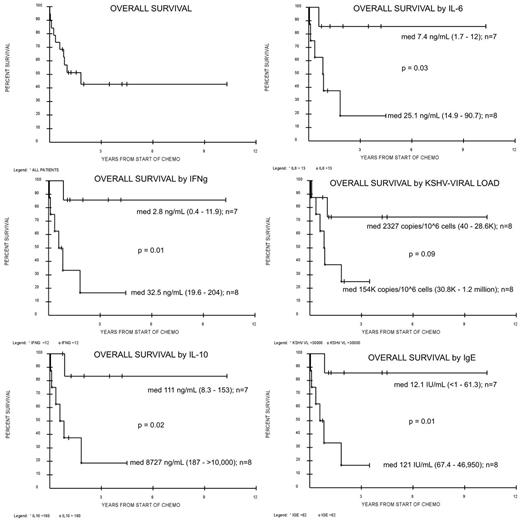Abstract
Introduction: Primary effusion lymphoma (PEL) and large cell lymphoma arising in Kaposi sarcoma-associated herpesvirus associated multicentric Castleman disease (KSHV-MCD) are KSHV-associated non-Hodgkin lymphomas (together, KSHV-NHL) with overlapping clinical and pathologic features. KSHV-NHL have biologic profiles distinct from other AIDS-related lymphomas, a poor prognosis and no established therapy. Immune dysregulation, including KSHV-associated interleukin (IL)-6 syndromes, contribute to pathobiology and may affect outcomes. We hypothesized that biomarkers of KSHV-associated immune activation and lymphoproliferation could predict overall survival (OS) in patients with KSHV-NHL treated with modified dose-adjusted (DA)-EPOCH (continuous infusional etoposide, vincristine, and doxorubicin with cyclophosphamide and prednisone).
Methods:We analyzed OS in a retrospective series of 19 patients with pathology-confirmed KSHV-NHL diagnosed 2000-2013 who were evaluated in the HIV & AIDS Malignancy Branch Clinic and received curative intent modified DA-EPOCH regimens. Therapies combined with DA-EPOCH included rituximab, bevacizumab, and/or high dose methotrexate. All patients received combination antiretroviral therapy. Baseline clinical laboratories and immunologic biomarkers as well as treatment factors were evaluated for prognostic value. Continuous parameters were dichotomized near the median (med). OS was evaluated using Kaplan-Meier methods and 2-sided log-rank test. Multivariable analysis employed Cox regression with backward selection, initially including variables with a univariate p ² 0.10. Correlations between significant prognostic markers were evaluated by Spearman's rank correlation.
Results: Med age was 44 years (22-69); 1 woman, 18 men; 17 had PEL, with extracavitary involvement in 11; 2 had large cell lymphoma arising in KSHV-MCD. 42% had HIV viral load (VL) < 100 copies/mL. Med CD4 was 120 cells/uL (Table 1). Med number of chemotherapy cycles was 6 (range 1-13). Best response: 10 patients (53%) had complete response, 2 achieved stable disease and 7 progressed. With 3.3 years med potential follow up, med OS was 1.8 years and 3-year OS was 42.8%. Baseline predictors for inferior OS in univariate analysis, were elevated interferon-gamma (IFNg), IL-10, IL-6, immunoglobulin E (IgE), and KSHV VL (Figure 1). Elevated ferritin (p=0.07) and decreased platelets (p = 0.1) also predicted OS. Hemoglobin, albumin, C-reactive protein, serum free light chains (FLC), LDH, CD4 count, HIV viremia, IL-8, tumor necrosis factor-a (TNFa), and treatment factors did not predict OS. Moderately strong to strong correlation between IL-10, IL-6 and IFNg (r=0.64 - 0.91); IL6 and IL-10 with ferritin (r=0.51- 0.59); and IL-10 with IgE (r=0.54) but not ferritin with IgE (r=0.11) were observed and affected selection models. In a Cox model with backward selection, levels above the med for IgE (HR 30, p=0.01) and ferritin (HR=13, p=0.03) were jointly predictive of OS. Excluding IgE from the model, elevated IL-10 was the best predictor of OS.
Conclusion: Modified DA-EPOCH resulted in 3-year OS of 43%. Improved targeted therapies are needed. Hyperferritinemea, elevated IgE and inflammatory human cytokine profiles associated with dysregulated KSHV-lytic activation (IL-10, IL-6 and KSHV-VL) and macrophage activation syndromes (ferritin, IFNg, IL-6 and IL-10) suggest that life-threatening abnormalities in both innate and acquired immunity are common in KSHV-NHL and contribute to pathogenesis and prognosis. IgE and ferritin require further evaluation in KSHV-associated diseases.
Baseline characteristics
| Characteristic . | Value . |
|---|---|
| Demographics | |
| Age, med (range)(IQR) | 44(22-69) |
| Sex, M:F | 18:1 |
| Race | n(%) |
| White | 9 (47) |
| Hispanic | 4 (21) |
| African American | 4 (21) |
| African Immigrant | 2 (11) |
| Clinical Characteristics | n(%) |
| KS | 14(74) |
| KSHV-MCD | 5(26) |
| HIV VL <100 copies/mL | 8(42) |
| Laboratory parameters | median (range) |
| CD4+ cells/uL | 120(15-1072) |
| Hemoglobin, g/dL | 9.3(7.4-13) |
| Platelets x1000/uL | 105(10-361) |
| Albumin, g/dL | 2.1(1.1-3.4) |
| C-reactive protein, g/dL | 52.25(7.96-164) |
| LDH,u/L | 198(87-999) |
| IgG, mg/dL | 1990(641-4900) |
| IgE, U/L | 67.4(1-46950) |
| Serum FLC Kappa, mg/dL | 8.66(1.46-59.8) |
| Serum FLC Lambda, mg/dL | 6.7(1.65-45.4) |
| Ferritin mcg/L | 908(87-4500) |
| KSHV VL, copies/106 PBMCs | 29727.5(40-1318182) |
| Characteristic . | Value . |
|---|---|
| Demographics | |
| Age, med (range)(IQR) | 44(22-69) |
| Sex, M:F | 18:1 |
| Race | n(%) |
| White | 9 (47) |
| Hispanic | 4 (21) |
| African American | 4 (21) |
| African Immigrant | 2 (11) |
| Clinical Characteristics | n(%) |
| KS | 14(74) |
| KSHV-MCD | 5(26) |
| HIV VL <100 copies/mL | 8(42) |
| Laboratory parameters | median (range) |
| CD4+ cells/uL | 120(15-1072) |
| Hemoglobin, g/dL | 9.3(7.4-13) |
| Platelets x1000/uL | 105(10-361) |
| Albumin, g/dL | 2.1(1.1-3.4) |
| C-reactive protein, g/dL | 52.25(7.96-164) |
| LDH,u/L | 198(87-999) |
| IgG, mg/dL | 1990(641-4900) |
| IgE, U/L | 67.4(1-46950) |
| Serum FLC Kappa, mg/dL | 8.66(1.46-59.8) |
| Serum FLC Lambda, mg/dL | 6.7(1.65-45.4) |
| Ferritin mcg/L | 908(87-4500) |
| KSHV VL, copies/106 PBMCs | 29727.5(40-1318182) |
Overall survival by immune parameters and KSHV viral load
Overall survival by immune parameters and KSHV viral load
Uldrick:Celgene Corporation: Research Funding. Off Label Use: Bevacizumab use in primary effusion lymphoma. Tosato:NIH: Has patent for KSHV-viral IL-6 assay Patents & Royalties. Yarchoan:Celgene: Research Funding.
Author notes
Asterisk with author names denotes non-ASH members.


